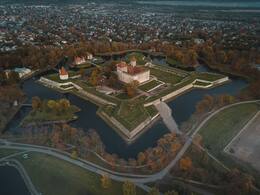Vyskupo Heinricho III pasmaugimas
1381 m. pilyje savo galą sutiko 80-metis Saare-Lääne vyskupas Heinrichas III.
1381 m., būdamas 80 metų, šioje pilyje mirė Ösel-Wiek vyskupas Heinrichas III.
Tarp nepaklusnaus vyskupo ir Hapsalu katedros kapitulos kilo aršus ginčas, kuriame vyskupas, kovojantis su lėšų trūkumu, buvo apkaltintas savavališku bažnyčios žemės ir turto, esančio už jo paties valdų ribų, pardavimu ir įkeitimu. Ginčas peraugo į neproporcingą situaciją, kai buvo grasinama pasitelkti užsienio valdžią į vidinį ginčą. Kanauninkas Hermanas Balne įsakė suimti užsispyrusį vyskupą ir išvežti jį į Kuresarės pilį. Vėliau, po šio perkėlimo, Heinricho III lavonas buvo rastas „Liūto duobėje“ – šachtoje, naudojamoje virtuvės maisto atliekoms šalinti ir kuria dalijosi trys prižiūrėtojai. Vyskupas buvo pasmaugtas per savotišką minios teisingumą, o pagrindinis įtariamasis buvo kanauninkas Balne. Metraštininkas Albertas Krantzas teigė, kad nei vienas religinis pareigūnas nebuvo sutikęs tokios siaubingos mirties nei prieš, nei po to.
Saremos muziejus
Susijusios vietos
Saremos muziejus
Kuresarės pilis yra pietiniame Kuresarės miesto pakraštyje, prie jūros.
Saremos muziejaus, įsikūrusio tvirtovėje, jubiliejus minimas vasario 17 d.: 1865 m. tą dieną buvo įkurta Saremos tyrimų draugija (Verain zur Kunde Oesels). Muziejus į pilį persikėlė 1897 m. Jo ekspozicija pristato Saremos gamtą ir istoriją. Didžiausias ir labiausiai dėmesį patraukiantis muziejaus eksponatas yra pati pilis – puikus karinių įtvirtinimų raidos XIV–XIX a. pavyzdys. Kuresarės pilis yra vienas autentiškiausių įtvirtinimų visoje Šiaurės Europoje.









